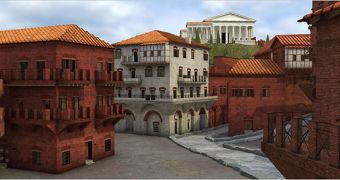For most of you, the Google Earth project doesn't require any supplementary explanation, but for those who are not that much up to date, I'll explain it briefly. The goal of the project is to map the planet's cities by means of satellite (or other high-distance aerial) images, allowing users to zoom in, for instance, from a continent scale to about 15-cm (6-inch) sized objects in some parts of the world.
Experts from Google Earth have made a step forward (or, should I say, backwards, chronologically speaking) with the addition of Ancient Rome 3D, a feature that will transport users 17 centuries back in time, during the rule of Constantine the Great. Bernard Frischer, director of the Institute for Advanced Technology in the Humanities at the University of Virginia, has been working on a 3D project involving ancient Rome for over 30 years along with partners in the US and Europe.
There are 7,000 buildings comprised in the feature, of which 250 are in high detail, with 31 designed based on UCLA's 1:1 scale models. The rest of the buildings are somewhat less detailed and designed based on 3D scans of the Museum of Roman Civilization's plaster replicas. Archaeologists and scholars have contributed to the accuracy of the resulting project and will continue to do so. Initially, Frischer conceived it as a 3D movie that would be viewed by a public wearing 3D glasses, much like the “3D Rewind Rome” project that we discussed in a recent article.
The mayor of Rome, Gianni Alemanno, stated that this would do much for the tourists who are not just content to seeing the ruins of the ancient city. “They may not be enough to involve the tourist in the experience of Roman civilization. The public needs the hook-up with virtual reality,” he explained. Meanwhile, Google Earth is open to involve other ancient cities in the project, as Michael T. Jones, chief technology officer of Google Earth, shared.
“When archaeologists rise up, we’re ready to share their research with the world. There’s no shortage of cities or civilizations that deserve to be understood in the same way,” stated Jones. A version 2.0 of Ancient Rome 3D is currently under development and it could even span across different points in Rome's history. “There’s always something to discover. Please don’t make me say it, but, after all, Rome wasn’t built in a day,” joked Professor Frischer.
For more detailed information about this project, go here. For US users, there's a video demonstration of the feature available here (the Google Earth software must be installed first, then select the “Gallery” folder on the left, and click on “Ancient Rome 3D” afterwards).

 14 DAY TRIAL //
14 DAY TRIAL //